
Video Upload Options
Reinforced concrete (RC) bridges often face great demands of strengthening or repair during their service life. Fe-based shape memory alloys (Fe-SMAs) as a kind of low-cost smart materials have great potential to enhance civil engineering structures. The stable shape memory effect of Fe-SMAs is generated by, taking Fe-Mn-Si alloys as an example, the martensite transformation of fcc(γ) → hcp(ε) and its reverse transformation which produces considerable recovery stress (400~500 MPa) that can be used as prestress for reinforcement of RC bridges.
1. Introduction
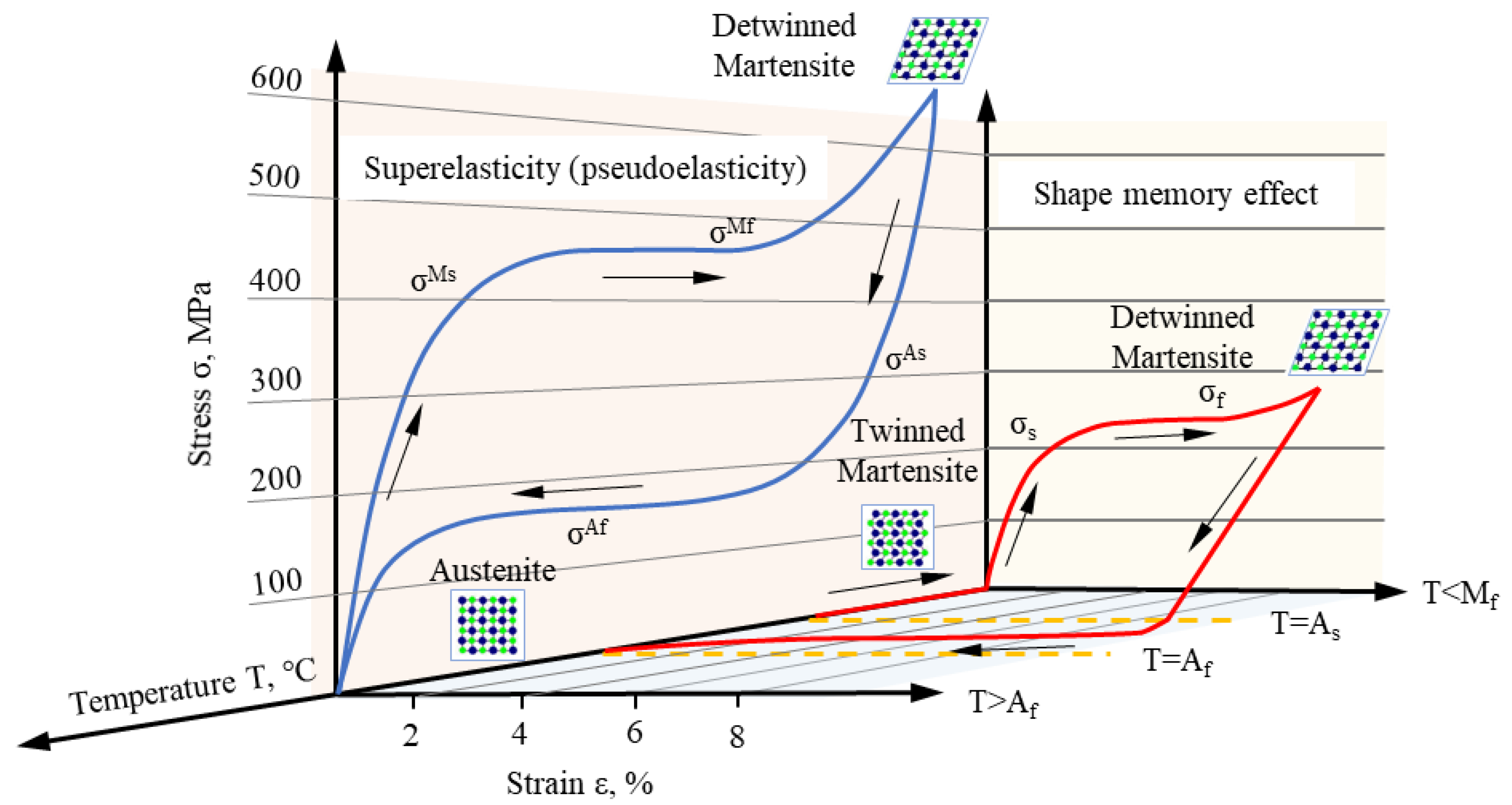
| Alloys | Density (kg/m3) | Elongation (%) | Yield Strength (MPa) | Tensile Strength (MPa) | Thermal Hysteresis (°C) | Recovery Stress (MPa) |
|---|---|---|---|---|---|---|
| Ni-Ti | 6400~6500 | 20~60 | 49.03~196.1 | 686.5~1078.7 | 2~30 | 300 |
| Fe-32%Mn-6%Si | 7200 | 28 | 330 | 700 | 100 | 200~300 |
| Fe-28%Mn-6%Si-5%Cr | 7200 | 35 | 320 | 1000 | 100 | 180~200 |
2. Reinforcement Mechanism of RC Bridges with Fe-SMAs
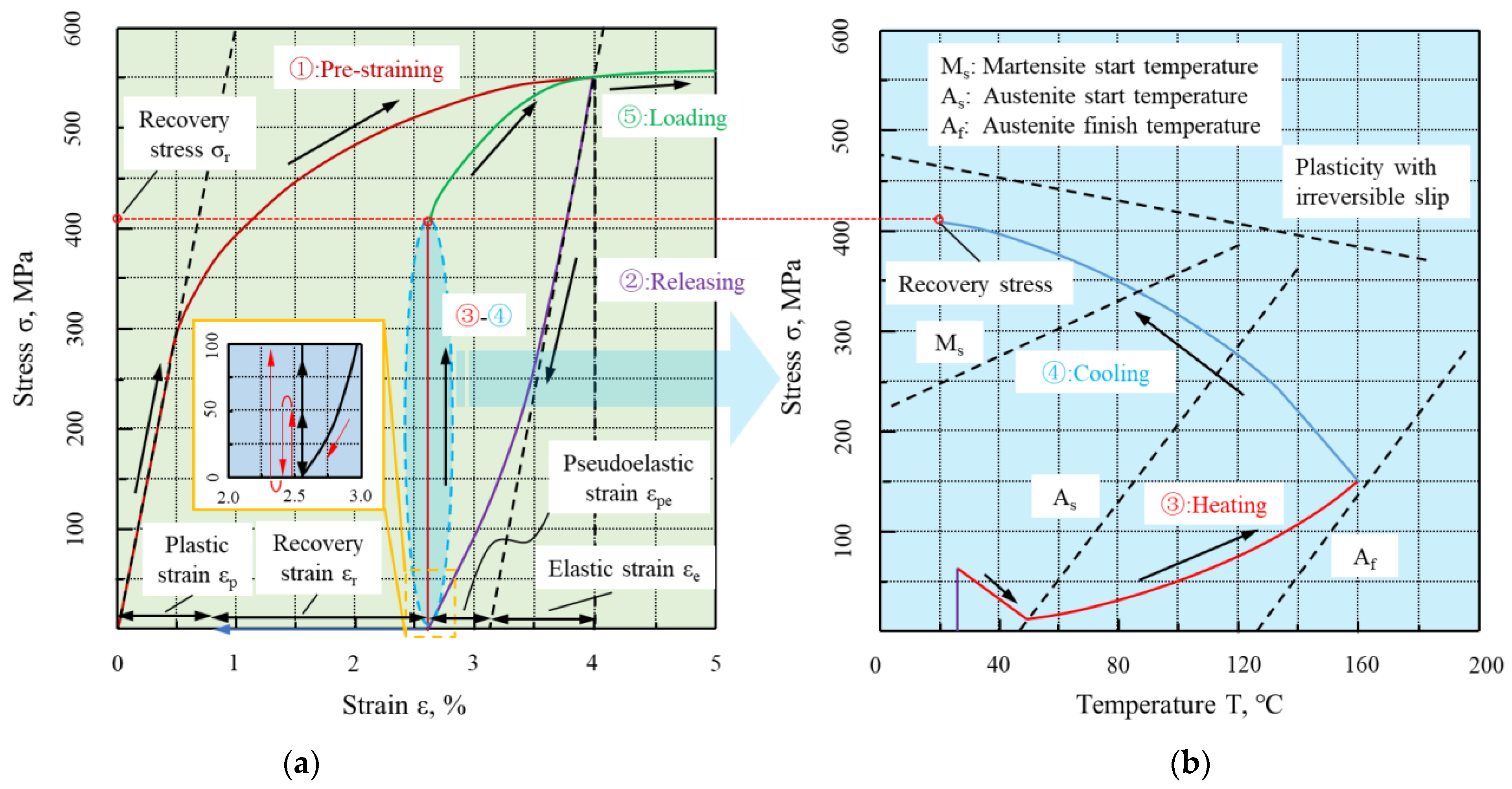
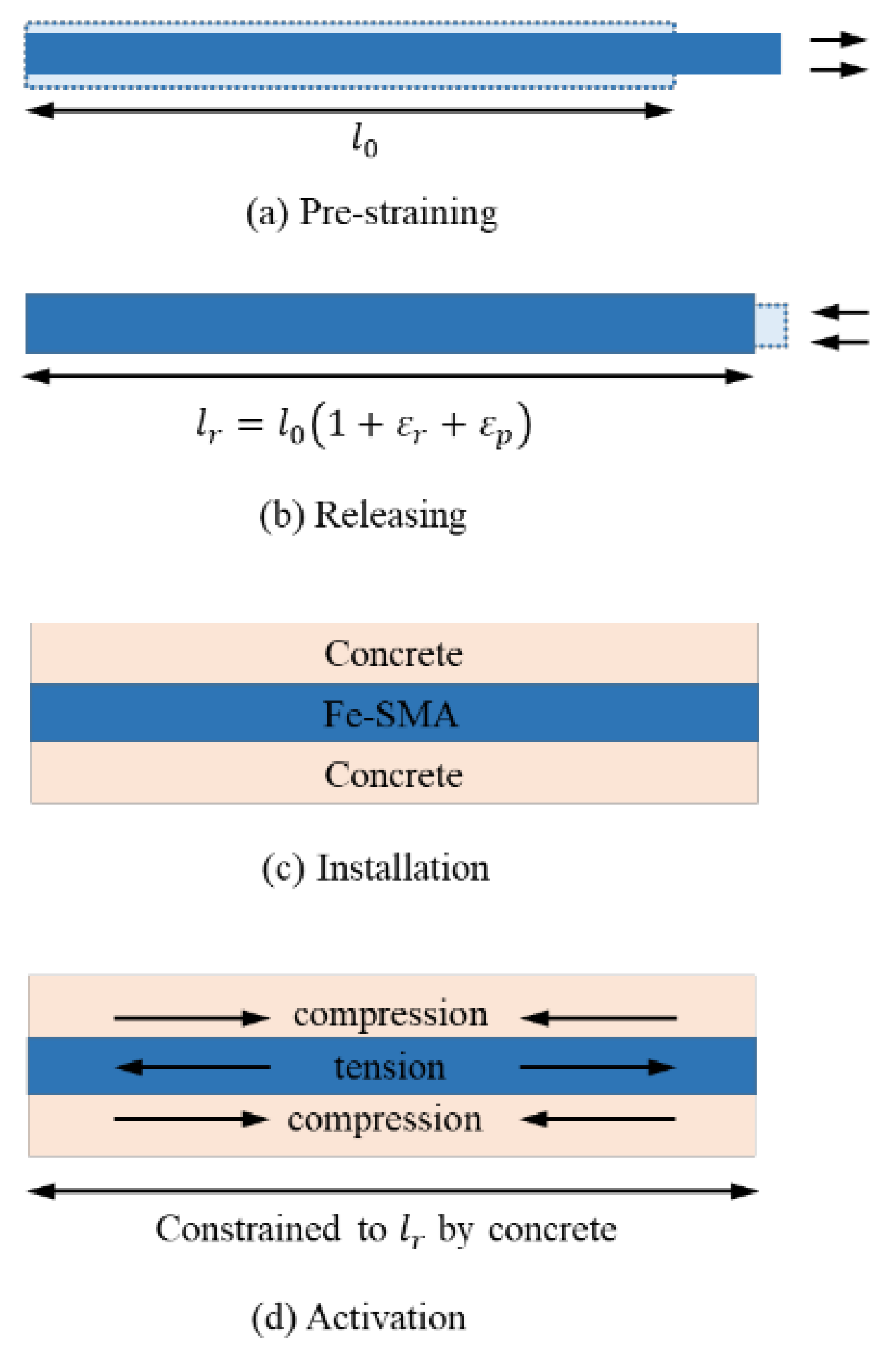
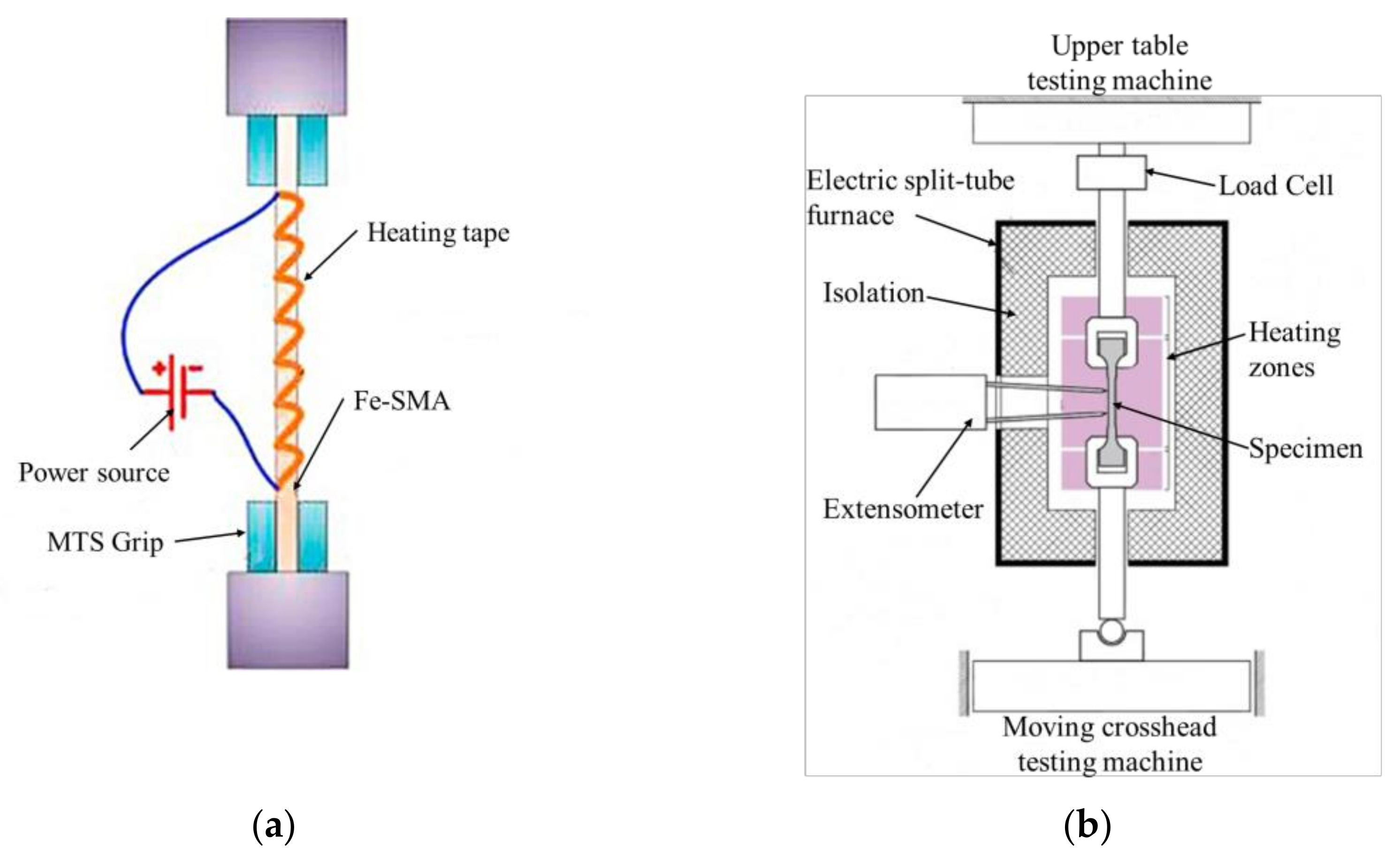
| Alloys | Specimens | Pre-Strain/% | Activation Modes | Control Details |
Activation Temperature/°C | Recovery Stress/MPa |
|---|---|---|---|---|---|---|
| Fe-17Mn-5Si-10Cr-4Ni-1 (V, C) (in mass %) | strips [40] | 4 | climate chamber | 2 °C/min | 160 | ~328.85 |
| strips [2] | 4 | climate chamber | 2 °C/min | 160 | 266 | |
| dog-bone shaped specimens [46] | 4 | climate chamber | 2 °C/min | 140 | 130 | |
| 160 | 400 | |||||
| strips [44] | 2 | electric resistance | 2 A/mm2 | 160 | 308 | |
| 4 | 160 | 348 | ||||
| bars [45] | 4 | electric resistance | 7.6 A/mm2 | ~160 | 285~307 | |
| ribbed strips [47] | 2 | electric resistance | 7.65~8.82 A/mm2 | 160 | 190~213 | |
| ~160 | 342 | |||||
| strips [6] | 2 | climate chamber | 2 °C/min | 160 | 342 | |
| resistive heating | 125 A/380 V | 180 | 380 | |||
| ribbed strips [48] | 4 | climate chamber | 2 °C/min | 160 | 250 | |
| 160 | 350 | |||||
| ribbed bars [55] | ~4 | cooper clamps | 3.5 A/mm2 | 160 | ~300 | |
| dog-bone-shaped specimens [56] | 2 | Inductive heating coil | 2 °C/min | 160 | 372 | |
| strips [57] | 2 | split-tube electric furnace | 5, 15, 50 °C/min | 160 | 358.6~377.9 | |
| dog-bone shaped specimens [36] | 4 | climate chamber | 0.1 °C/s | 160~225 | ~500 | |
| dog-bone shaped specimens [37] | 4 | climate chamber | 0.1 °C/s | 225 | 380 | |
| Fe-28Mn-6Si-5Cr-0.53Nb-0.06C (in mass %) | strips [45] | 5 | infrared furnace | - | 397 | 250 |
| Fe-19Mn-4Si-8Cr-4Ni-0.01C (at.%) | wires [52] | 5 | Hot gun | - | 200 | 245 |
| 5 | 250 | 280 | ||||
| 5 | 300 | 315 | ||||
| 4 | 250 | 268 | ||||
| 6 | 250 | 219 | ||||
| Fe-Mn-Si produced by AWAJI |
bars [51] | 6 | flexible heating tapes | - | 350 | 215~160 |
| bars [49] | 6 | heating tape | - | 350 | ~200 | |
| bars [50] | 6 | flexible heating tapes | - | 315 | 130 |
3. Reinforcement Techniques of RC Bridges with Fe-SMAs
3.1. Summary of Reinforcement Techniques
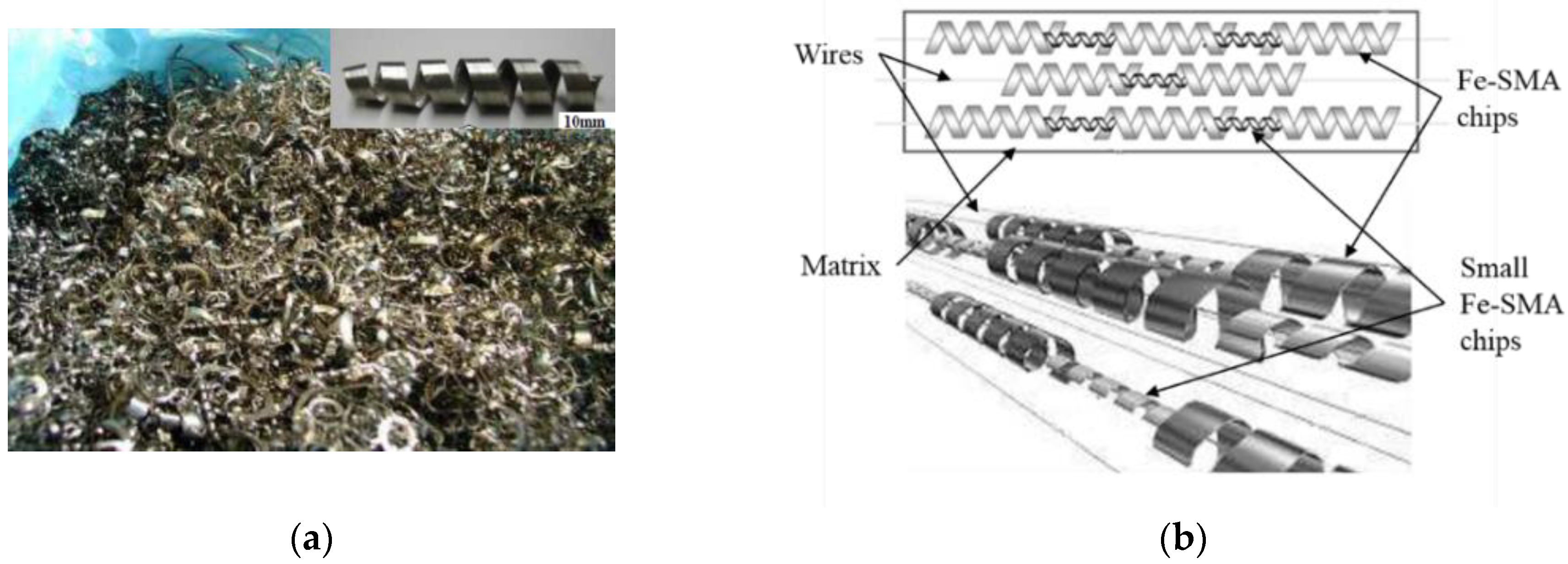
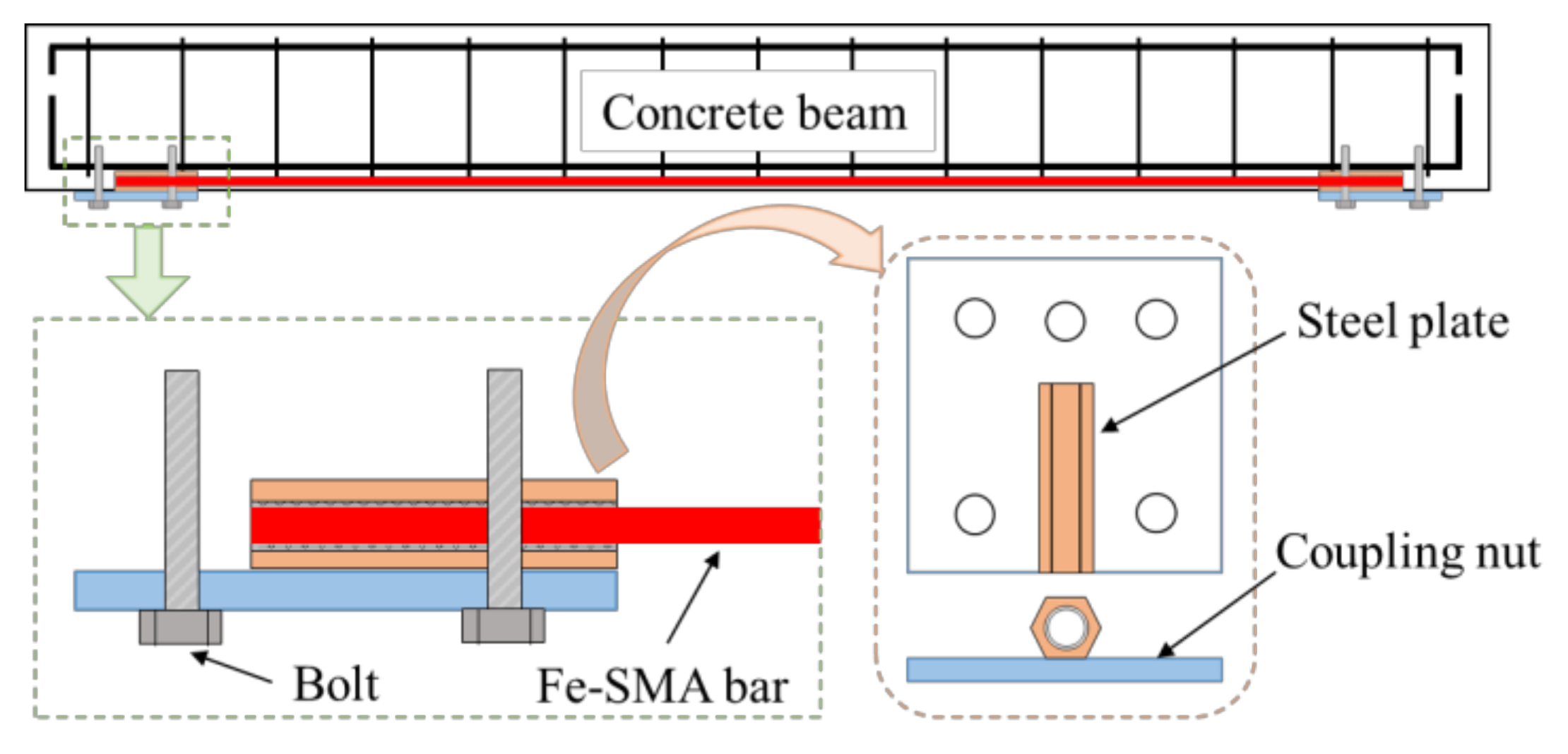
3.2. Reinforcement Method with Anchorage
3.3. Reinforcement Method without Anchorage

4. Reinforcement Applications of RC Beams with Fe-SMAs
4.1. Application on Reinforcement of Small-Scale Specimens
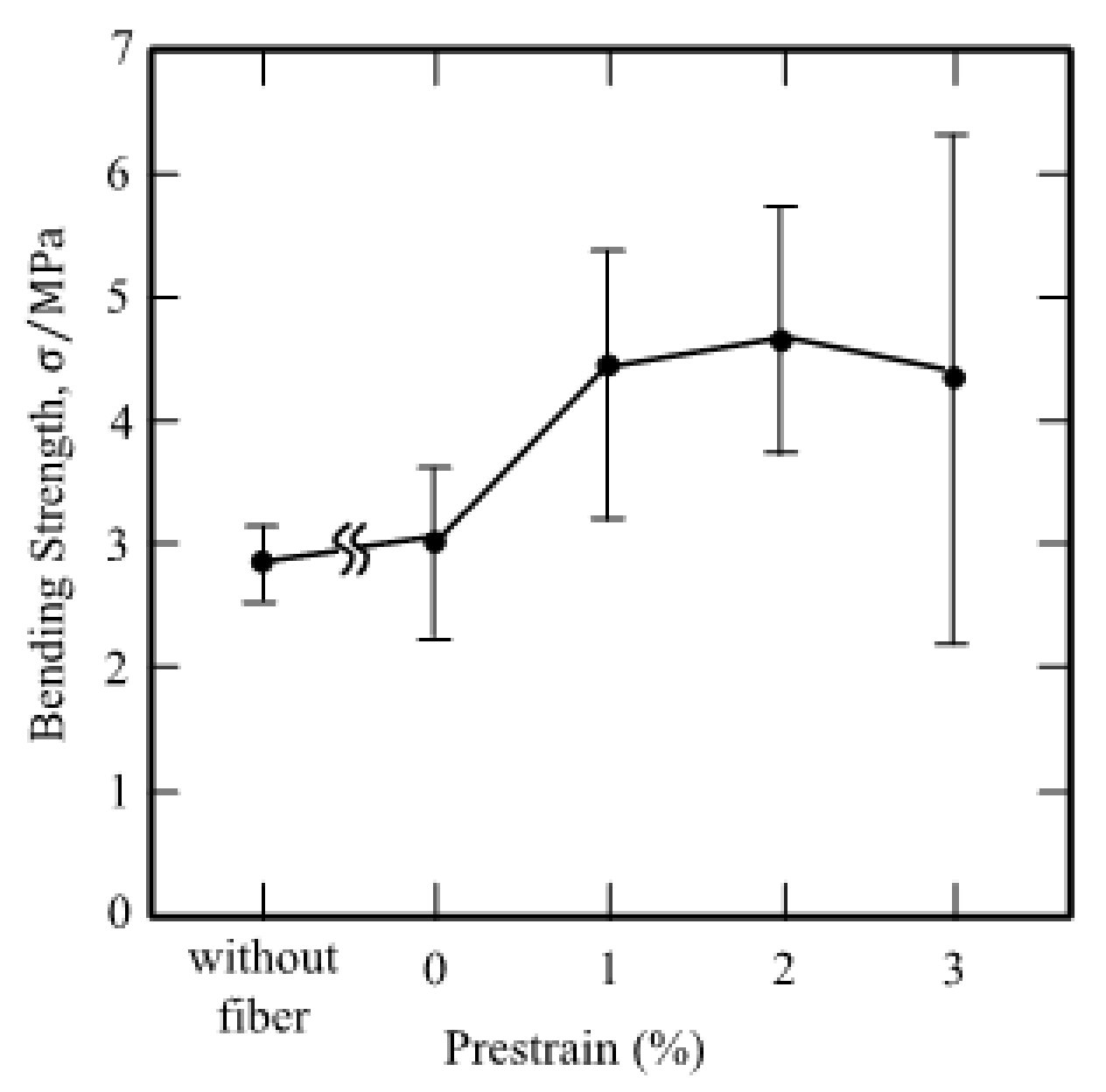
Figure 8. Bending strengths of the plaster prism specimens [59].
4.2. Application on Reinforcement of Full-Scale Beams
4.2.1. Flexural Performance

Figure 9. Load–deflection curves of beams [50].
Embedding ribbed Fe-SMA bars in the shotcrete layer is another promising technique to improve the flexural performance of RC members. Shahverdi et al. [45] first introduced this reinforcement method into RC beams and studied bending behaviors by a four-point bending test. The cracking load of the beam embedded with two ribbed Fe-SMA bars was up to 9.5 kN, which is 76% higher than the reference beam with normal steel. In another study [48], they pointed out that the prestressing force of the Fe-SMA bars can be completely transferred to the concrete beam through the shear stress in the interface.
4.2.2. Shear Performance
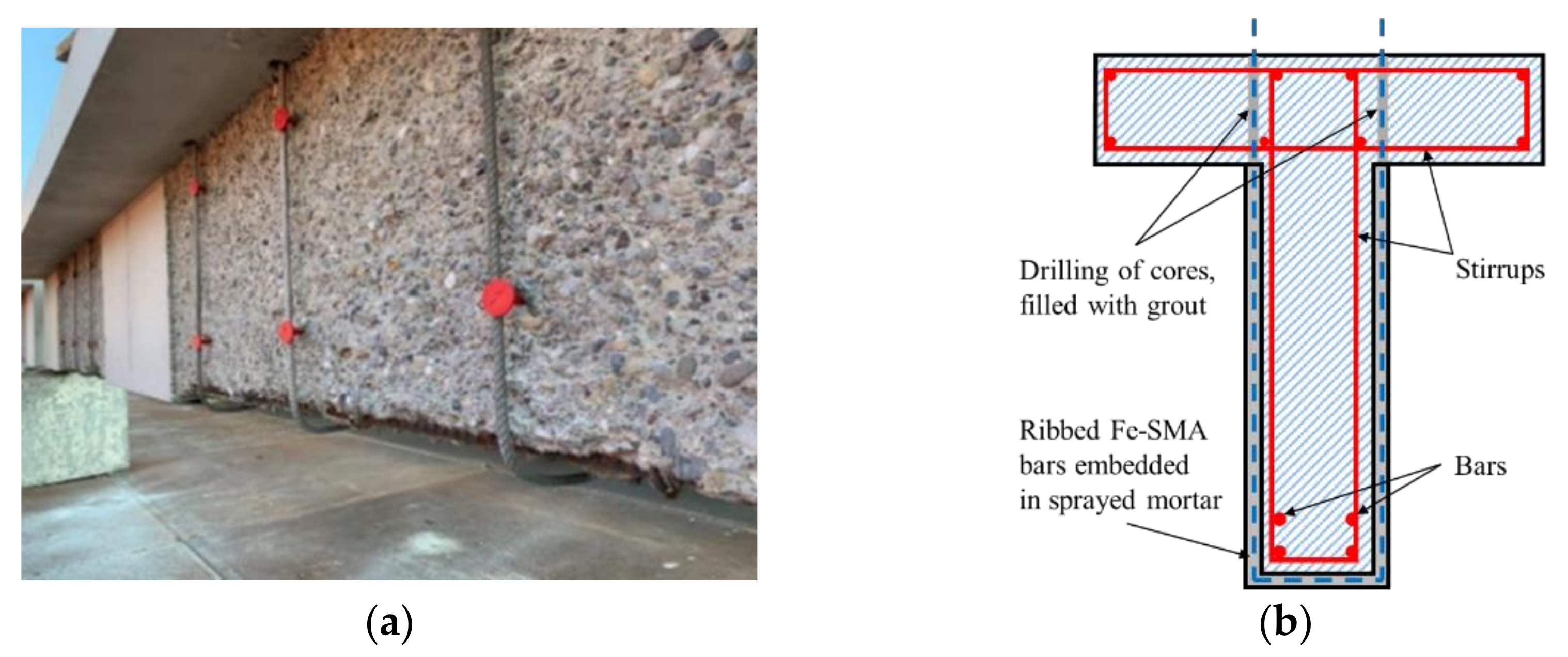
Figure 10. Shear reinforcement with Fe-SMAs embedded in sprayed mortar layer (adapted from [58]): (a) installed memory-steel stirrups on-site; (b) cross-section of reinforced beam.
4.2.3. Other Performances
5. Prospects of Future Development
The identified future potential for Fe-SMAs’ application:
(1) Fe-SMAs have not yet been widely accepted by the market, because their cost is higher than other reinforcement materials, such as CFRP, which is mainly caused by a backward production process. Therefore, improving the manufacturing technology of Fe-SMAs is meaningful to reduce the cost and promote their applications in civil engineering.
(2) Compared with other SMAs, the good weldability of Fe-SMAs is a significant advantage in civil engineering applications, which can greatly reduce the cost of connection. However, previous studies are very limited to investigate the weldability of Fe-SMAs. Therefore, developing weldability, including welding methods and processes, of Fe-SMAs with dissimilar alloys, especially constructional steels, is worth considering.
(3) Fe-SMAs as reinforcement materials are subjected to the humid and variable environments, even corrosive conditions (sea water, chemical waste liquid, etc.). Improving the corrosion resistance of Fe-SMAs should be highlighted, especially for the rehabilitation of
(4) Bridges constantly undergo the traffic load in service life; hence, the shrinkage and creep of concrete inevitably occur due to the varying of temperature or humidity, resulting in prestress loss of Fe-SMAs. Therefore, the prestress loss should be considered in the design stage.
(5) Most studies in the field of reinforcement by Fe-SMAs have mainly focused on the component level, but few studies concern the application of in-service bridges that are undergoing multi-factor effects, such as cyclic loads, elevated temperatures, and corrosive environments. In the future, applying Fe-SMAs to strengthen the existing deteriorative structures may be a promising research direction.
6. Conclusions
This research introduces the classification, mechanism of SME, and development history of shape memory alloys, especially Fe-Mn-Si alloys. The development of the mechanism, techniques, and applications of Fe-SMAs in enhancing RC bridges in the past two decades have been summarized, and some perspectives for future potential development have been put forward. The following conclusions can be drawn:
(1) Fe-SMAs represented by Fe-Mn-Si alloys have the advantages of low cost, wide thermal hysteresis, excellent SME, and high elastic modulus, which guarantee great potential for their application in civil engineering.
(2) The SME of Fe-Mn-Si alloys is caused by the γ → ε martensite transformation and its reverse transformation can produce huge recovery stress (400~500 MPa) which can be used as prestress in reinforcement.
(3) Activation methods of Fe-SMAs are varied, including thermal resistance heating, climate chamber heating, flexible tape heating, infrared radiation heating, heat gun heating, flame heating, inductive coil heating, electric furnace heating, autoclave heating, and so on. However, resistance heating is the most widely used activation method in the application, especially in civil engineering.
(4) NSM Fe-SMA technique is the most common method to strengthen RC beams and can effectively protect Fe-SMA strips from damage. Moreover, embedding ribbed Fe-SMA bars in the shotcrete layer is another promising method.
(5) The strengthening of RC beams with Fe-SMAs has achieved great application effect on flexural performance, shear performance, fatigue performance, durability, etc., hence it deserves to be promoted worldwide in the rehabilitation of RC bridges in the near future, especially under the global goal of carbon neutrality.
References
- Hosseini, A.; Michels, J.; Izadi, M.; Ghafoori, E. A Comparative Study between Fe-SMA and CFRP Reinforcements for Prestressed Strengthening of Metallic Structures. Constr. Build. Mater. 2019, 226, 976–992.
- Czaderski, C.; Shahverdi, M.; Brönnimann, R.; Leinenbach, C.; Motavalli, M. Feasibility of Iron-Based Shape Memory Alloy Strips for Prestressed Strengthening of Concrete Structures. Constr. Build. Mater. 2014, 56, 94–105.
- Cladera, A.; Montoya-Coronado, L.A.; Ruiz-Pinilla, J.G.; Ribas, C. Shear Strengthening of Slender Reinforced Concrete T-Shaped Beams Using Iron-Based Shape Memory Alloy Strips. Eng. Struct. 2020, 221, 111018.
- Schranz, B.; Czaderski, C.; Vogel, T.; Shahverdi, M. Bond Investigations of Prestressed, near-Surface-Mounted, Ribbed Memory-Steel Bars with Full Bond Length. Mater. Des. 2020, 196, 109145.
- Schranz, B.; Czaderski, C.; Vogel, T.; Shahverdi, M. Bond Behaviour of Ribbed Near-Surface-Mounted Iron-Based Shape Memory Alloy Bars with Short Bond Lengths. Mater. Des. 2020, 191, 108647.
- Michels, J.; Shahverdi, M.; Czaderski, C. Flexural Strengthening of Structural Concrete with Iron-Based Shape Memory Alloy Strips. Struct. Concr. 2018, 19, 876–891.
- Ghafoori, E. Editorial for Special Issue on Sustainable Metallic Structures. Eng. Struct. 2019, 183, 83.
- Hariri, N.G.; Almadani, I.K.; Osman, I.S. A State-of-the-Art Self-Cleaning System Using Thermomechanical Effect in Shape Memory Alloy for Smart Photovoltaic Applications. Materials 2022, 15, 5704.
- Rogowski, J.; Kotynia, R. Comparison of Prestressing Methods with CFRP and SMA Materials in Flexurally Strengthened RC Members. Materials 2022, 15, 1231.
- Huang, W.M.; Ding, Z.; Wang, C.C.; Wei, J.; Zhao, Y.; Purnawali, H. Shape Memory Materials. Mater. Today 2001, 13, 54–61.
- Da Silva Teixeira, R.; de Oliveira, R.V.; Rodrigues, P.F.; Mascarenhas, J.; Neves, F.C.F.P.; dos Santos Paula, A. Microwave versus Conventional Sintering of NiTi Alloys Processed by Mechanical Alloying. Materials 2022, 15, 5506.
- Carreira, P.; Gatões, D.; Alves, N.; Ramos, A.S.; Vieira, M.T. Searching New Solutions for NiTi Sensors through Indirect Additive Manufacturing. Materials 2022, 15, 5007.
- Otsuka, K. Science and Technology of Shape-Memory Alloys: New Developments. MRS Bull. 2002, 27, 91–100.
- Buehler, W.J.; Gilfrich, J.V.; Wiley, R.C. Effect of Low-Temperature Phase Changes on the Mechanical Properties of Alloys near Composition TiNi. J. Appl. Phys. 1963, 34, 1475–1477.
- Zhu, L.; Liu, Y.; Li, M.; Lu, X.; Zhu, X. Calculation Model of Mechanical and Sealing Properties of NiTi Alloy Corrugated Gaskets under Shape Memory Effect and Hyperelastic Coupling: Two Sealing Properties. Materials 2022, 15, 4659.
- Yang, H.; Yan, W.; Deng, X.; Zhang, M.; Wang, Y. Improving the Shape Memory Effect of a Fe-Mn-Si-Cr-Ni Alloy through Shot Peening. Materials 2022, 15, 2585.
- Mantovani, D. Shape Memory Alloys: Properties and Biomedical Applications. JOM 2000, 52, 36–44.
- Otsuka, K.; Ren, X. Physical Metallurgy of Ti–Ni-Based Shape Memory Alloys. Prog. Mater. Sci. 2005, 50, 511–678.
- Mohd Jani, J.; Leary, M.; Subic, A.; Gibson, M.A. A Review of Shape Memory Alloy Research, Applications and Opportunities. Mater. Des. 2014, 56, 1078–1113.
- Branco, M.; Gonçalves, A.; Guerreiro, L.; Ferreira, J. Cyclic Behavior of Composite Timber-Masonry Wall in Quasi-Dynamic Conditions Reinforced with Superelastic Damper. Constr. Build. Mater. 2014, 52, 166–176.
- DesRoches, R.; McCormick, J.; Delemont, M. Cyclic Properties of Superelastic Shape Memory Alloy Wires and Bars. J. Struct. Eng. 2004, 130, 38–46.
- Cladera, A.; Weber, B.; Leinenbach, C.; Czaderski, C.; Shahverdi, M.; Motavalli, M. Iron-Based Shape Memory Alloys for Civil Engineering Structures: An Overview. Constr. Build. Mater. 2014, 63, 281–293.
- Ölander, A. An Electrochemical Investigation of Solid Cadmium-Gold Alloys. J. Am. Chem. Soc. 1932, 54, 3819–3833.
- Saunders, N.; Miodownik, A.P. The Cu-Sn (Copper-Tin) System. Bull. Alloy. Phase Diagr. 1990, 11, 278–287.
- Otsuka, K.; Wayman, K.M. Shape Memory Materials; Cambridge University Press: Cambridge, UK, 1998.
- Auricchio, F. Shape Memory Alloys: Applications, Micromechanics, Macromodelling and Numerical Simulations. Ph.D. Thesis, University of California at Berkeley, Berkeley, CA, USA, 1995.
- Araki, Y.; Endo, T.; Omori, T.; Sutou, Y.; Koetaka, Y.; Kainuma, R.; Ishida, K. Potential of Superelastic Cu–Al–Mn Alloy Bars for Seismic Applications. Earthq. Eng. Struct. Dyn. 2011, 40, 107–115.
- Czaderski, C.; Hahnebach, B.; Motavalli, M. RC Beam with Variable Stiffness and Strength. Constr. Build. Mater. 2006, 20, 824–833.
- Tiwari, N.D.; Gogoi, A.; Hazra, B.; Wang, Q. A Shape Memory Alloy-Tuned Mass Damper Inerter System for Passive Control of Linked-SDOF Structural Systems under Seismic Excitation. J. Sound Vib. 2021, 494, 115893.
- Sato, A.; Chishima, E.; Soma, K.; Mori, T. Shape Memory Effect in γ Transformation in Fe-30Mn-1Si Alloy Single Crystals. Acta Metall. 1982, 30, 1177–1183.
- Zhou, L. Research of Fe-Mn-Si Based Shape Memory Alloy and Its Coupler. Master’s Thesis, Fuzhou University, Fuzhou, China, 2004.
- Soroushian, P.; Ostowari, K.; Nossoni, A.; Chowdhury, H. Repair and Strengthening of Concrete Structures through Application of Corrective Posttensioning Forces with Shape Memory Alloys. Transp. Res. Rec. 2001, 1770, 20–26.
- Lei, Z. Fe-based Shape-memory Alloy and its Applications. Dev. Appl. Mater. 2000, 15, 40–45.
- Sawaguchi, T.; Kikuchi, T.; Ogawa, K.; Kajiwara, S.; Ikeo, Y.; Kojima, M.; Ogawa, T. Development of Prestressed Concrete Using Fe–Mn–Si-Based Shape Memory Alloys Containing NbC. Mater. Trans. 2006, 47, 580–583.
- Wei, Z.; Yuhua, W.; Ning, L.; Wenling, X.; Shanhua, W. Directional Precipitation of Carbides Induced by γ/ɛ Interfaces in an FeMnSiCrNiC Alloy Aged after Deformation at Different Temperature. Mater. Sci. Eng. A 2007, 459, 324–329.
- Li, K.; Dong, Z.; Liu, Y.; Zhang, L. A Newly Developed Fe-Based Shape Memory Alloy Suitable for Smart Civil Engineering. Smart Mater. Struct. 2013, 22, 045002.
- Dong, B.Z.; Klotz, U.E.; Leinenbach, C.; Bergamini, A.; Czaderski, C.; Motavalli, M. A Novel Fe-Mn-Si Shape Memory Alloy with Improved Shape Recovery Properties by VC Precipitation. Adv. Eng. Mater. 2009, 11, 40–44.
- Michels, J.; Shahverdi, M.; Czaderski, C.; El-hacha, R. Mechanical Performance of Iron-Based Shape-Memory Alloy Ribbed Bars for Concrete Prestressing. Mater. J. 2018, 115, 877–886.
- Montoya-coronado, L.A.; Ruiz-pinilla, J.G.; Ribas, C.; Cladera, A. Experimental Study on Shear Strengthening of Shear Critical RC Beams Using Iron-Based Shape Memory Alloy Strips. Eng. Struct. 2019, 200, 109680.
- Shahverdi, M.; Michels, J.; Czaderski, C.; Motavalli, M. Iron-Based Shape Memory Alloy Strips for Strengthening RC Members: Material Behavior and Characterization. Constr. Build. Mater. 2018, 173, 586–599.
- Lee, W.J.; Weber, B.; Feltrin, G.; Czaderski, C.; Motavalli, M. Stress Recovery Behaviour of an Fe-Mn-Si-Cr-Ni-VC Shape Memory Alloy Used for Prestressing. Smart Mater. Struct. 2013, 22, 125037.
- Dong, Z.Z.; Kajiwara, S.; Kikuchi, T.; Sawaguchi, T. Effect of Pre-Deformation at Room Temperature on Shape Memory Properties of Stainless Type Fe–15Mn–5Si–9Cr–5Ni–(0.5–1.5)NbC Alloys. Acta Mater. 2005, 53, 4009–4018.
- Hong, K.; Lee, S.; Han, S.; Yeon, Y. Evaluation of Fe-Based Shape Memory Alloy (Fe-SMA) as Strengthening Material for Reinforced Concrete Structures. Appl. Sci. 2018, 8, 730.
- Hong, K.; Lee, S.; Yeon, Y.; Jung, K. Flexural Response of Reinforced Concrete Beams Strengthened with Near—Surface—Mounted Fe—Based Shape—Memory Alloy Strips. Int. J. Concr. Struct. Mater. 2018, 12, 45.
- Shahverdi, M.; Czaderski, C.; Annen, P.; Motavalli, M. Strengthening of RC Beams by Iron-Based Shape Memory Alloy Bars Embedded in a Shotcrete Layer. Eng. Struct. 2016, 117, 263–273.
- Lee, W.J.; Weber, B.; Feltrin, G.; Motavalli, M.; Leinenbach, C. Thermomechanical Characterization of an Fe-Mn-Si-Cr-Ni-VC Shape Memory Alloy for Application in Prestressed Concrete Structures. In Proceedings of the 2013 World Congress on Advances in Structural Engineering and Mechanics (ASEM 13), Jeju, Korea, 8–12 September 2013; pp. 544–552.
- Shahverdi, M.; Czaderski, C.; Motavalli, M. Iron-Based Shape Memory Alloys for Prestressed near-Surface Mounted Strengthening of Reinforced Concrete Beams. Constr. Build. Mater. 2016, 112, 28–38.
- Shahverdi, M.; Czaderski, C.; Michels, J.; Motavalli, M. Iron-based Shape Memory Alloys for Structural Applications. In Proceedings of the BIT’S 1st Annual World Congress of Smart Materials, Busan, Korea, 23–25 March 2015.
- Rojob, H.; El-Hacha, R. Performance of RC Beams Strengthened with Self-Prestressed Fe-SMA Bars Exposed to Freeze-Thaw Cycles and Sustained Load. Eng. Struct. 2018, 169, 107–118.
- Rojob, H.; El-Hacha, R. Ductility Behavior of RC Beams Strengthened in Flexure with NSM Iron-Based Shape Memory Alloy Bars. In Proceedings of the Third Conference on Smart Monitoring, Assessment and Rehabilitation of Civil Structures, Antalya, Turkey, 7–9 September 2015.
- Rojob, H.; El-Hacha, R. Fatigue Performance of RC Beams Strengthened with Self-Prestressed Iron-Based Shape Memory Alloys. Eng. Struct. 2018, 168, 35–43.
- Choi, E.; Ostadrahimi, A.; Kim, W.J.; Seo, J. Prestressing Effect of Embedded Fe-Based SMA Wire on the Flexural Behavior of Mortar Beams. Eng. Struct. 2021, 227, 111472.
- El-hacha, R. Flexural Strengthening of Large-Scale Reinforced Concrete Beams Using near- Surface-Mounted Self-Prestressed Iron-Based Shape-Memory Alloy Strips. PCI J. 2018, 63, 55–65.
- Cao, B.; Iwamoto, T. An Experimental Investigation on Rate Dependency of Thermomechanical and Stress-Induced Martensitic Transformation Behavior in Fe-28Mn-6Si-5Cr Shape Memory Alloy under Compression. Int. J. Impact Eng. 2019, 132, 103284.
- Izadi, M.R.; Ghafoori, E.; Shahverdi, M.; Motavalli, M.; Maalek, S. Development of an Iron-Based Shape Memory Alloy (Fe-SMA) Strengthening System for Steel Plates. Eng. Struct. 2018, 174, 433–446.
- Ghafoori, E.; Hosseini, E.; Leinenbach, C.; Michels, J.; Motavalli, M. Fatigue Behavior of a Fe-Mn-Si Shape Memory Alloy Used for Prestressed Strengthening. Mater. Des. 2017, 133, 349–362.
- Ghafoori, E.; Neuenschwander, M.; Shahverdi, M.; Czaderski, C.; Fontana, M. Elevated Temperature Behavior of an Iron-Based Shape Memory Alloy Used for Prestressed Strengthening of Civil Structures. Constr. Build. Mater. 2019, 211, 437–452.
- Czaderski, C.; Shahverdi, M.; Michels, J. Iron Based Shape Memory Alloys as Shear Reinforcement for Bridge Girders. Constr. Build. Mater. 2020, 274, 121793.
- Watanabe, Y.; Miyazaki, E.; Okada, H. Enhanced Mechanical Properties of Fe-Mn-Si-Cr Shape Memory Fiber/Plaster Smart Composite. Mater. Trans. 2002, 43, 974–983.
- Watanabe, Y.; Wakatsuki, T.; Sato, H.; Maruyama, T. Bending Strength of Fe-Mn-Si-Cr Shape Memory Alloy Machining Chips Reinforced Smart Composite. Tetsu-to-Hagane 2007, 92, 562–566.
- Moser, K.; Bergamini, A.; Christen, R.; Czaderski, C. Feasibility of Concrete Prestressed by Shape Memory Alloy Short Fibers. Mater. Struct. 2005, 38, 593–600.
- Zhang, Y.; Mi, C. Strengthening Bonding Strength in NiTi SMA Fiber-Reinforced Polymer Composites through Acid Immersion and Nanosilica Coating. Compos. Struct. 2020, 239, 112001.
- Rojob, H.; El-hacha, R. Self-Prestressing Using Iron-Based Shape Memory Alloy for Flexural Strengthening of Reinforced Concrete Beams. Struct. J. 2017, 114, 523–532.
- Zerbe, L.; Reda, M.; Dawood, M.; Belarbi, A.; Senouci, A.; Gencturk, B.; Alansari, M.; Michels, J. Behavior of Retrofitted Concrete Members Using Iron-Based Shape Memory Alloys. In Proceedings of the Fourth Conference on Smart Monitoring, Assessment and Rehabilitation of Civil Structures, Zurich, Switzerland, 13–15 September 2017.
- Choi, E.; Ostadrahimi, A.; Lee, J.-H. Pullout Resistance of Crimped Reinforcing Fibers Using Cold-Drawn NiTi SMA Wires. Constr. Build. Mater. 2020, 265, 120858.
- Izadi, M.; Motavalli, M.; Ghafoori, E. Iron-Based Shape Memory Alloy (Fe-SMA) for Fatigue Strengthening of Cracked Steel Bridge Connections. Constr. Build. Mater. 2019, 227, 116800.
- Osawa. High Speed-High Efficiency Milling of Fe-Mn-Si Shape Memory Alloys: Processing for Bolt Holes in the Crane Rail Joint Bar. Bull. Hum. Resour. Dev. 2008, 20, 47–51.
- Shahverdi, M.; Czaderski, C.; Motavalli, M. Strengthening of RC Beams with Iron-Based Shape Memory Alloy Strips. In Proceedings of the 3rd Conference on Smart Monitoring, Assessment and Rehabilitation of Structures, M.B.T.-S., Antalya, Turkey, 7–9 September 2015.
- Beni, D.; Kazuhiro, A.; Masato, A.; Kazuhisa. FE-based ballast settlement analysis of railway track with a railjoint. In Proceedings of the BT-Proceedings of the Conference on Computational Engineering & Science, Darmstadt, Germany, 28–29 September 2017.
- Abouali, S.; Shahverdi, M.; Ghassemieh, M.; Motavalli, M. Nonlinear Simulation of Reinforced Concrete Beams Retrofitted by Near- Surface Mounted Iron-Based Shape Memory Alloys. Eng. Struct. 2019, 187, 133–148.
- Rojob, H.; El-hacha, R. Numerical Investigation of the Flexural Performance of RC Beam Strengthened with Iron-Based Shape Memory Alloys Bar. In Proceedings of the 27th Biennial National Conference of the Concrete Institute of Australia in conjunction with the 69th RILEM Week (Concrete 2015), Melbourne, Australia, 2 September 2015.
- De Lorenzis, L.; Teng, J.G. Near-Surface Mounted FRP Reinforcement: An Emerging Technique for Strengthening Structures. Compos. Part B Eng. 2007, 38, 119–143.
- Ruiz-Pinilla, J.G.; Montoya-Coronado, L.A.; Ribas, C.; Cladera, A. Finite Element Modeling of RC Beams Externally Strengthened with Iron-Based Shape Memory Alloy (Fe-SMA) Strips, Including Analytical Stress-Strain Curves for Fe-SMA. Eng. Struct. 2020, 223, 111152.
- Shahverdi, M.; Czaderski, C.; Michels, J.B.T.-S. “Memory Steel” for Shear Reinforcement of Concrete Structures. In Proceedings of the International Conference on Smart Monitoring, Assessment and Rehabilitation of Civil Structures (SMAR 2019), Potsdam, Germany, 27–29 August 2019.
- Lee, D.; Cheng, L. Bond of NSM Systems in Concrete Strengthening—Examining Design Issues of Strength, Groove Detailing and Bond-Dependent Coefficient. Constr. Build. Mater. 2013, 47, 1512–1522.
- Shahverdi, M.; Czaderski, C. Long-Term Behavior of Reinforced Concrete Beams Strengthened by Iron-Based Shape Memory Alloy Strips. In Proceedings of the SMAR 2019—Fifth Conference on Smart Monitoring, Assessment and Rehabilitation of Civil Structures, Potsdam, Germany, 27–29 August 2019; pp. 1–8.
- Yeon, Y.; Hong, K.; Shim, W. Long-Term Behavior of Reinforced Concrete Beams Strengthened with Near-Surface Mounted Fe-Based Shape Memory Alloy Strips. J. Korean Soc. Adv. Compos. Struct. 2020, 11, 11–17.




